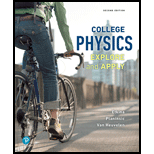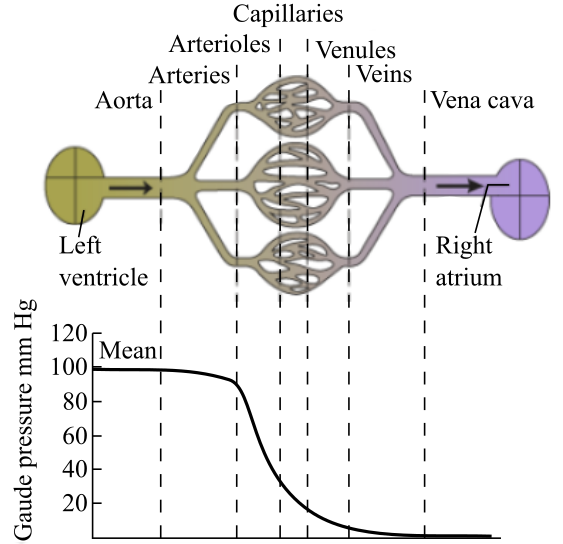
EBK COLLEGE PHYSICS
2nd Edition
ISBN: 9780134605500
Author: ETKINA
Publisher: PEARSON CO
expand_more
expand_more
format_list_bulleted
Concept explainers
Question
Chapter 14, Problem 69RPP
To determine
The reason behind the need of having huge number of capillaries and venules in a human circulatory system from the given options.
(a) They provide nutrients (such as
(b) They distribute water uniformly throughout the body.
(c) They reduce the resistance of the circulatory system.
(d) b and c
(e) a, b, and c

Expert Solution & Answer
Want to see the full answer?
Check out a sample textbook solution
Students have asked these similar questions
micro wave.
micro wave.
Answer to 53
Chapter 14 Solutions
EBK COLLEGE PHYSICS
Ch. 14 - Prob. 1RQCh. 14 - Prob. 2RQCh. 14 - Prob. 3RQCh. 14 - Prob. 4RQCh. 14 - Prob. 5RQCh. 14 - Review Question 14.6 Describe some of the...Ch. 14 - Review Question 14.7 When a skydiver falls at...Ch. 14 - Prob. 1MCQCh. 14 - A river flows downstream and widens, and the flow...Ch. 14 - Prob. 3MCQ
Ch. 14 - Prob. 4MCQCh. 14 - 5. As a river approaches a dam, the width of the...Ch. 14 - Prob. 6MCQCh. 14 - What is viscous flow? a. A physical phenomenon b....Ch. 14 - 8. The heart does about 1 J of work pumping blood...Ch. 14 - Several air bubbles are present in water flowing...Ch. 14 - A small metal ball is released from just below the...Ch. 14 - 11. A small metal ball is launched downward from...Ch. 14 - You have two identical large jugs with small holes...Ch. 14 - 13. Why does much of the pressure drop in the...Ch. 14 - If you partly close the end of a hose with your...Ch. 14 - Compare and contrast work-energy bar charts, which...Ch. 14 - Consider Bernoulli's equation, Poiseuille's law,...Ch. 14 - You need a liquid that will exhibit turbulent flow...Ch. 14 - Watering plants You water flowers outside your...Ch. 14 - 2. Irrigation canal You live neat an irrigation...Ch. 14 - Prob. 3PCh. 14 - 4. The main waterline for a neighborhood delivers...Ch. 14 - Prob. 5PCh. 14 - Prob. 6PCh. 14 - Represent the process sketched in Figure P14.7...Ch. 14 - * Represent the process sketched in Figure P14.8...Ch. 14 - 9. Fluid flow Problem Write a symbolic equation...Ch. 14 - Prob. 10PCh. 14 - Prob. 11PCh. 14 - Prob. 12PCh. 14 - 13. An application of Bernoulli’s equation is...Ch. 14 - Prob. 14PCh. 14 - Prob. 15PCh. 14 - * Wine flow from barrel While visiting a winery,...Ch. 14 - Water flow in city water system Water is pumped at...Ch. 14 - * The pressure of water flowing through a...Ch. 14 - * Siphoning water You want to siphon rainwater and...Ch. 14 - Prob. 20PCh. 14 - * BIO Blood flow In artery Blood flows at an...Ch. 14 - Prob. 22PCh. 14 - Prob. 23PCh. 14 - 24. * BIO Flutter in blood vessel A person has a ...Ch. 14 - 25. * BIO Effect of smoking on arteriole radius...Ch. 14 - Prob. 26PCh. 14 - 27. * You have a U-shaped tube open at both ends....Ch. 14 - Prob. 28PCh. 14 - Prob. 29PCh. 14 - Prob. 30PCh. 14 - Prob. 31PCh. 14 - Prob. 32PCh. 14 - 33. * BIO Blood flow through capillaries Your...Ch. 14 - Prob. 34PCh. 14 - * A piston pushes 20C water through a horizontal...Ch. 14 - Prob. 36PCh. 14 - * A syringe is filled with water and fixed at the...Ch. 14 - Prob. 38PCh. 14 - 39. * EST Air drag when biking Estimate the drag...Ch. 14 - Prob. 41PCh. 14 - * EST Earth exerts a constant downward force of...Ch. 14 - Prob. 43PCh. 14 - *Terminal speed of balloon A balloon of mass m...Ch. 14 - You observe four different liquids (listed with...Ch. 14 - Prob. 48GPCh. 14 - 50. ** Viscous friction with Bernoulli We can...Ch. 14 - 51. ** (a) Show that the work W done per unit time...Ch. 14 - Prob. 52GPCh. 14 - 53. ** BIO Essential hypertension Suppose your...Ch. 14 - Prob. 54GPCh. 14 - A 0.20-m-radius balloon falls at terminal speed 40...Ch. 14 - 56. ** Terminal speed of skier A skier going down...Ch. 14 - kg/m3 is placed in a 20C lake Determine the...Ch. 14 - 58. ** EST Comet crash On June 30, 1908, a...Ch. 14 - EST Intravenous (IV) feeding A patient in the...Ch. 14 - EST Intravenous (IV) feeding A patient in the...Ch. 14 - EST Intravenous (IV) feeding A patient in the...Ch. 14 - EST Intravenous (IV) feeding A patient in the...Ch. 14 - EST Intravenous (IV) feeding A patient in the...Ch. 14 - EST Intravenous (IV) feeding A patient in the...Ch. 14 - EST Intravenous (IV) feeding A patient in the...Ch. 14 - Prob. 66RPPCh. 14 - Prob. 67RPPCh. 14 - Prob. 68RPPCh. 14 - Prob. 69RPPCh. 14 - Which number below best represents the ratio of...
Knowledge Booster
Learn more about
Need a deep-dive on the concept behind this application? Look no further. Learn more about this topic, physics and related others by exploring similar questions and additional content below.Similar questions
- An object is placed 37.4cm in front of a diverging lens with a focal length of 18.1 cm. Please provide your answers in units of cm if necessary. bookmark_border1.0p3a Find the image distance. Answer Updated 6 days ago Show feedback bookmark_border1.0p3b Is the image real or virtual? Real Virtual Updated 6 days ago Show feedback bookmark_border1.0p3c Suppose the object is brought to a distance of 10.3 cm in front of the lens. Where is the image now with respect to its previous location? (Note: Ensure the sign convention you use is consistent by treating all image distances on the object side of the lens as negative.) Answer Updated 7 minutes ago Show feedback bookmark_border1.0p3d How has the height of the image changed if the object is 84.2 cm tall? Answerarrow_forwardn object is placed 37.4cm in front of a diverging lens with a focal length of 18.1 cm. Please provide your answers in units of cm if necessary. bookmark_border1.0p3a Find the image distance. Answer Updated 6 days ago Show feedback bookmark_border1.0p3b Is the image real or virtual? Real Virtual Updated 6 days ago Show feedback bookmark_border1.0p3c Suppose the object is brought to a distance of 10.3 cm in front of the lens. Where is the image now with respect to its previous location? (Note: Ensure the sign convention you use is consistent by treating all image distances on the object side of the lens as negative.) Answer Updated just now Show feedback bookmark_border1.0p3d How has the height of the image changed if the object is 84.2 cm tall? Answerarrow_forwardCan you draw a FBD and KD please!arrow_forward
- If a 120- volt circuit feeds four 40-watt fluorescent lamps, what current (in amps) is drawn if the power factor is 0.912 0.33 0.68 1.21 3.3arrow_forwardHow do you draw a diagram of the ruler and mass system in equilibrium identifying the anti-clockwise torque and clockwise torque? How do I calculate the anti-clockwise torque and the clockwise torque of the system with the ruler and the washers, does it come from the data in table 2? Please help, thank you!arrow_forwardA long, narrow steel rod of length 2.5000 m at 33.5°C is oscillating as a pendulum about a horizontal axis through one end. If the temperature drops to 0°C, what will be the fractional change in its period?arrow_forward
- How long should a pendulum be in order to swing back and forth in 1.6 s?arrow_forwardLECTURE HANDOUT: REFRACTION OF LIGHT I. Review Each of the diagrams at right shows a ray incident on a boundary between two media. Continue each of the rays into the second medium. Using a dashed line, also draw the path that the wave would have taken if it had continued without "bending." Does the ray representing a wave "bend" toward or away from the normal when: the wave speed is smaller in the second medium? ⚫the wave speed is larger in the second medium? Faster medium Slower medium Slower medium Faster medium II. Qualitative applications of refraction A. Place a coin at the bottom of an empty can or cup. Look into the cup at the coin while your partner slowly moves the can away from you until you no longer see the coin. Now, keep your head steady while your partner gently pours water into the cup. 1. Describe your observations. Switch roles with your partner so that you each have a turn. Shown below are cross-sectional diagrams of the cup for when it was empty and when it was…arrow_forwardProblem Six. A 70 kg student in the figure balances a 1200 kg elephant on a hydraulic lift with diameter 2.0 m that is filled with oil which has a density of 900 kg/m³. How many 80 kg students would have to stand on the first piston in order to raise the elephant by 2.55 m? 80 kg 1200 kg 17.) (A) 5 (D) 8 (B) 6 (E) 9 (C) 7 Oil 2.0 m 5arrow_forward
arrow_back_ios
SEE MORE QUESTIONS
arrow_forward_ios
Recommended textbooks for you
 College PhysicsPhysicsISBN:9781938168000Author:Paul Peter Urone, Roger HinrichsPublisher:OpenStax College
College PhysicsPhysicsISBN:9781938168000Author:Paul Peter Urone, Roger HinrichsPublisher:OpenStax College Physics for Scientists and EngineersPhysicsISBN:9781337553278Author:Raymond A. Serway, John W. JewettPublisher:Cengage Learning
Physics for Scientists and EngineersPhysicsISBN:9781337553278Author:Raymond A. Serway, John W. JewettPublisher:Cengage Learning Physics for Scientists and Engineers with Modern ...PhysicsISBN:9781337553292Author:Raymond A. Serway, John W. JewettPublisher:Cengage Learning
Physics for Scientists and Engineers with Modern ...PhysicsISBN:9781337553292Author:Raymond A. Serway, John W. JewettPublisher:Cengage Learning College PhysicsPhysicsISBN:9781285737027Author:Raymond A. Serway, Chris VuillePublisher:Cengage Learning
College PhysicsPhysicsISBN:9781285737027Author:Raymond A. Serway, Chris VuillePublisher:Cengage Learning Physics for Scientists and Engineers: Foundations...PhysicsISBN:9781133939146Author:Katz, Debora M.Publisher:Cengage Learning
Physics for Scientists and Engineers: Foundations...PhysicsISBN:9781133939146Author:Katz, Debora M.Publisher:Cengage Learning College PhysicsPhysicsISBN:9781305952300Author:Raymond A. Serway, Chris VuillePublisher:Cengage Learning
College PhysicsPhysicsISBN:9781305952300Author:Raymond A. Serway, Chris VuillePublisher:Cengage Learning

College Physics
Physics
ISBN:9781938168000
Author:Paul Peter Urone, Roger Hinrichs
Publisher:OpenStax College

Physics for Scientists and Engineers
Physics
ISBN:9781337553278
Author:Raymond A. Serway, John W. Jewett
Publisher:Cengage Learning

Physics for Scientists and Engineers with Modern ...
Physics
ISBN:9781337553292
Author:Raymond A. Serway, John W. Jewett
Publisher:Cengage Learning

College Physics
Physics
ISBN:9781285737027
Author:Raymond A. Serway, Chris Vuille
Publisher:Cengage Learning

Physics for Scientists and Engineers: Foundations...
Physics
ISBN:9781133939146
Author:Katz, Debora M.
Publisher:Cengage Learning

College Physics
Physics
ISBN:9781305952300
Author:Raymond A. Serway, Chris Vuille
Publisher:Cengage Learning